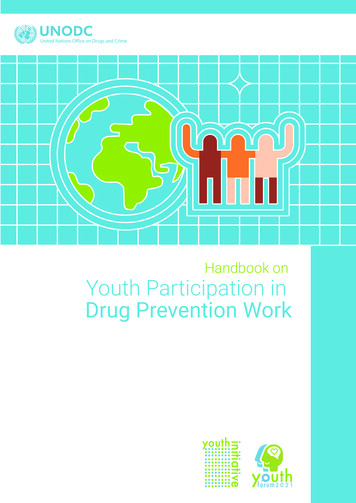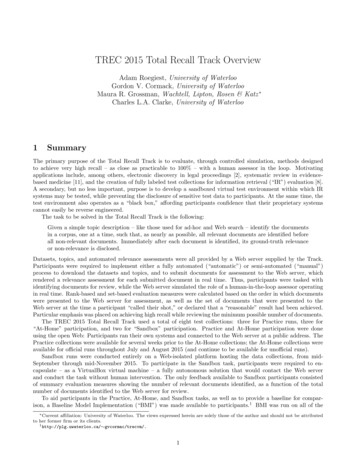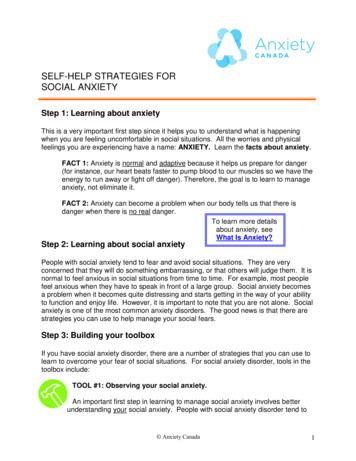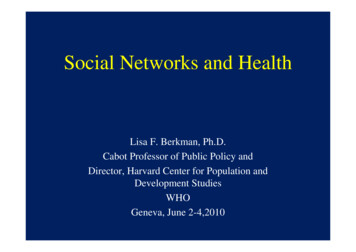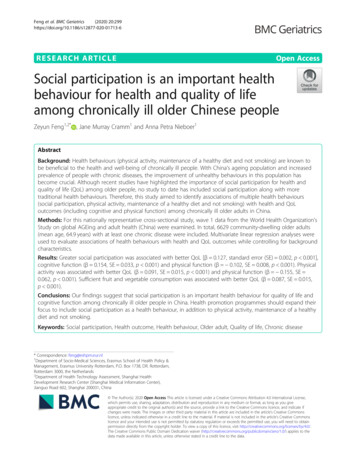
Transcription
Feng et al. BMC Geriatrics(2020) SEARCH ARTICLEOpen AccessSocial participation is an important healthbehaviour for health and quality of lifeamong chronically ill older Chinese peopleZeyun Feng1,2* , Jane Murray Cramm1 and Anna Petra Nieboer1AbstractBackground: Health behaviours (physical activity, maintenance of a healthy diet and not smoking) are known tobe beneficial to the health and well-being of chronically ill people. With China’s ageing population and increasedprevalence of people with chronic diseases, the improvement of unhealthy behaviours in this population hasbecome crucial. Although recent studies have highlighted the importance of social participation for health andquality of life (QoL) among older people, no study to date has included social participation along with moretraditional health behaviours. Therefore, this study aimed to identify associations of multiple health behaviours(social participation, physical activity, maintenance of a healthy diet and not smoking) with health and QoLoutcomes (including cognitive and physical function) among chronically ill older adults in China.Methods: For this nationally representative cross-sectional study, wave 1 data from the World Health Organization’sStudy on global AGEing and adult health (China) were examined. In total, 6629 community-dwelling older adults(mean age, 64.9 years) with at least one chronic disease were included. Multivariate linear regression analyses wereused to evaluate associations of health behaviours with health and QoL outcomes while controlling for backgroundcharacteristics.Results: Greater social participation was associated with better QoL [β 0.127, standard error (SE) 0.002, p 0.001],cognitive function (β 0.154, SE 0.033, p 0.001) and physical function (β 0.102, SE 0.008, p 0.001). Physicalactivity was associated with better QoL (β 0.091, SE 0.015, p 0.001) and physical function (β 0.155, SE 0.062, p 0.001). Sufficient fruit and vegetable consumption was associated with better QoL (β 0.087, SE 0.015,p 0.001).Conclusions: Our findings suggest that social participation is an important health behaviour for quality of life andcognitive function among chronically ill older people in China. Health promotion programmes should expand theirfocus to include social participation as a health behaviour, in addition to physical activity, maintenance of a healthydiet and not smoking.Keywords: Social participation, Health outcome, Health behaviour, Older adult, Quality of life, Chronic disease* Correspondence: feng@eshpm.eur.nl1Department of Socio-Medical Sciences, Erasmus School of Health Policy &Management, Erasmus University Rotterdam, P.O. Box 1738, DR. Rotterdam,Rotterdam 3000, the Netherlands2Department of Health Technology Assessment, Shanghai HealthDevelopment Research Center (Shanghai Medical Information Center),Jianguo Road 602, Shanghai 200031, China The Author(s). 2020 Open Access This article is licensed under a Creative Commons Attribution 4.0 International License,which permits use, sharing, adaptation, distribution and reproduction in any medium or format, as long as you giveappropriate credit to the original author(s) and the source, provide a link to the Creative Commons licence, and indicate ifchanges were made. The images or other third party material in this article are included in the article's Creative Commonslicence, unless indicated otherwise in a credit line to the material. If material is not included in the article's Creative Commonslicence and your intended use is not permitted by statutory regulation or exceeds the permitted use, you will need to obtainpermission directly from the copyright holder. To view a copy of this licence, visit http://creativecommons.org/licenses/by/4.0/.The Creative Commons Public Domain Dedication waiver ) applies to thedata made available in this article, unless otherwise stated in a credit line to the data.
Feng et al. BMC Geriatrics(2020) 20:299BackgroundHumans are living much longer today than they did 100years ago; this great achievement in human developmentis accompanied by new challenges [1]. Chronic diseasespose an increasing global problem [2], and older adultsare more vulnerable to such conditions (e.g. cardiovascular diseases, diabetes and lung diseases) [3].China has the largest ageing population in the world, andthe rate of ageing in this country has accelerated over recentyears [4]. At the end of 2018, the population of China included more than 249.49 million (about 17.9%) people aged 60 years [5]. Approximately 150 million of these olderadults have at least one chronic illness [6]. For decades, research has consistently shown that people with chronic conditions are at greater risk of worse quality of life [7–9] andhealth outcomes [10] than are those without chronic disease.Thus, the identification of modifiable factors to prevent thedeterioration of health and quality of life among chronicallyill older adults is crucial in a time of ageing societies.Considerable evidence shows that healthy lifestylehabits, such as physical activity and maintenance of ahealthy diet, can slow the deterioration of cognitivefunction, quality of life and physical function in chronically ill (older) populations [11–16]. For example, physicalactivity has been associated with better cognitive function among older adults with hypertension [16], and hasbeen found to enhance the quality of life of patients withtype 2 diabetes [12–15] and heart failure [11, 12].Not only traditional health behaviours (i.e. physical activity, maintenance of a healthy diet and not smoking), butalso older people’s ability to stay socially active and connected to others is essential for health and quality of lifeoutcomes. Social participation is considered to be a criticalelement of active ageing [17] and has been incorporatedinto many theoretical models of successful ageing [18]. Ithas been associated with longevity [19], self-rated health[6], quality of life [20, 21] and functional ability [22]. Notably, the positive influence of social participation onhealth was found to be greatest among older adults [23].For example, the association between social participationand cognitive function was shown to be stronger amongolder adults than among younger persons [22]. A possibleexplanation is that active engagement in social activitiesgives older people opportunities to experience more dynamic environments, which is considered to be beneficialfor the maintenance of cognition by stimulating neurogenesis, even at older ages [22].Less attention has been paid to whether chronically illolder adults can benefit from social participation [24, 25].Several studies have shown that social participation affectsthe (health-related) quality of life of older adults with arthritis [26, 27] and post-stroke [28]. Research on chronicallyill older Chinese adults, however, is limited. In the firststudy of its kind, Hu and colleagues [29] found noPage 2 of 10association between social participation and quality of lifeamong older Chinese adults with diabetes. However, theirmeasurement of social participation focused mainly onformal organisations (e.g. sports clubs), which might haveled to underestimation and contributed to inaccurate estimation of this association; in China, joining formal socialorganisations, such as sports clubs and culture associations, is not common [29], whereas activities such as public square dancing (guang chang wu in Mandarin) [30],group tai chi practice [31] and group singing in parks [32]are common. Furthermore, Hu and colleagues’ [29] findings were not generalisable to the whole country becauseof the sampling strategy used.More importantly, although previous research has identified the importance of traditional health behaviours andsocial participation separately, no study to date has incorporated social participation as a health behaviour inaddition to physical activity, maintenance of a healthy dietand not smoking. Thus, the purpose of this study was toinvestigate the associations of social participation andthese traditional health behaviours with health andquality-of-life outcomes among chronically ill older adultsin China, using a large nationally representative dataset.MethodsParticipants and dataData for this study were taken from wave 1 of the WorldHealth Organization’s (WHO’s) Study on global AGEingand adult health (SAGE), the most recent data availablefrom China. SAGE is a longitudinal study for which nationally representative data were collected from adultsaged 50 years from six low- and middle-income countries (China, Ghana, India, Mexico, the Russian Federation and South Africa) using a multistage, stratifiedcluster sampling approach. The effectiveness and highresponse rate of SAGE are attributable to proper planning and organization from the initiation of the study[33]. All investigators, supervisors and interviewers weretrained to administer the survey in the field, introduceSAGE to the sampled households [34]. In China, wave 1of SAGE was implemented in 16 strata in 8 provinces/municipalities [34]. A five-stage cluster sampling strategy wasused to select participants, who were contacted by telephone or in person, and about 200 investigators were involved in wave 1 data collection via face-to-face interviewsbetween 2008 and 2010 [34]. About half of the interviewswere computer assisted (CAPI), and half involved manualdata recording [35]. Investigators visited the selectedhouseholds and collected information about householdrosters; then, the survey team completed the questionnaires at a central location (e.g. a neighbourhood office) orat respondents’ homes [34]. Each respondent received asmall gift for his or her cooperation [34]. An excellent response rate was achieved (93%), similar to rates for other
Feng et al. BMC Geriatrics(2020) 20:299surveys (e.g. the China Health and Retirement Longitudinal Study) conducted among older people in China. Detailed information about the SAGE data collectionprocedures can be found elsewhere [34].SAGE consists of national longitudinal studies of olderpeople (age 50 years) in six lower- and upper–middle-income countries. The instruments and threshold age used arecompatible with other large longitudinal ageing studies conducted in high-income countries, such as the US Health andRetirement Study (HRS) and the Korean Longitudinal Studyon Ageing (KLoSA), enabling sound international comparisons of the ageing process, health and well-being amongmiddle-aged and older adults [35]. The original wave 1 sample included 13,367 participants from China. We enrolled respondents aged 50 years with chronic disease (angina,arthritis, asthma, chronic lung disease, diabetes, diagnoseddepression, hypertension, paralysis or stroke), leading to afinal sample of 6629 respondents. Most (n 6194, 93.4%)older persons in the sample were aged 50–80 years; peopleaged 50–59 years made up the largest group (n 2270,34.2%), those aged 60–69 years comprised the second largestgroup (n 2154, 32.5%) and only 6.6% (n 435) of the sample was aged 80 years. The procedure for sample selectionis summarized in Fig. 1.MeasuresChronic conditionsFor self-reporting of chronic conditions, respondentswere asked whether they had been diagnosed with anyof the following: i) angina or angina pectoris (heart disease), ii) arthritis (or rheumatism, osteoarthritis), iii)asthma (an allergic respiratory disease), iv) chronic lungdisease (emphysema, bronchitis, COPD), v) diabetesFig. 1 Flow chart on how the final sample (n 6629) was derivedPage 3 of 10(high blood sugar), vi) depression, vii) high blood pressure (hypertension), viii) paralysis and ix) stroke. Thequestions were formatted as: “Have you ever been diagnosed with/told by a health care professional you have ? ” Respondents provided yes/no answers. They wereconsidered to have chronic (a) disease(s) if they answered “yes” to any of the questions.Health behavioursSocial participation was measured using summed scoresfor the 9-item questionnaire developed for the SAGE[36] (Additional file 1). Items enquire about respondents’frequency of community involvement in the past 12months, with responses ranging from ‘never’ (1) to ‘daily’(5). The Cronbach’s alpha value for the questionnaire inthis study was 0.63. We used adequate fruit and vegetable intake as an indicator of healthy diet (insufficient,fewer than two servings of fruit and three servings of vegetables/day; sufficient, two or more servings of fruit andthree or more servings of vegetables/day] [37]. Version 2of the General Physical Activity Questionnaire was usedto measure physical activity [36]. Participants were askedto report the average number of days per week and timein which they engaged in vigorous and moderate physical activity. We recorded physical activity as sufficientor insufficient according to the WHO threshold of 150min/week [38]. Smoking habits were assessed by askingwhether participants were daily smokers (yes/no).Outcome variablesQuality of lifeQuality of life was measured using the 8-item WorldHealth Organization quality of life measure (WHOQoL)
Feng et al. BMC Geriatrics(2020) 20:299[35] (Additional file 2). Respondents were asked to ratetheir satisfaction with life in general and in different domains (e.g. finances, health and relationships) on a 5point scale ranging from 0 (‘not at all/very poor’) to 5(‘completely/very good’). Total scores were calculated bysumming the item scores and rescaling the result to 0–100 [39]. According to previous research [40], the 8item WHOQoL is useful for the assessment of quality oflife in older populations. The Cronbach’s alpha value ofthe instrument in this study was 0.86.Cognitive functionCognitive function was measured by administering five cognitive performance tests (forward and backward digit spans,immediate and delayed verbal recall, and verbal fluency) [41].Forward digit span was tested by asking participants to repeat progressively longer number series in the exact order inwhich they had been presented [41, 42]. Backward digit spanwas tested by asking participants to repeat such series backwards [41]. Scores (longest spans repeated) for the forwardand backward digit spans ranged from 0 to 9 and 0 to 8, respectively (total possible scores, 1–17) [42]. Immediate anddelayed verbal recall was measured by asking participants toread 10 words aloud and soon thereafter to recall as manywords as possible in 1 min [41]. The same test was repeatedthree times. Scores ranged from 0 to 10 [43]. Verbal fluencywas assessed by asking respondents to name as many animals as they could in 1 min [42]. Scores were based on thenumber of correctly named animals, with repeated namescounted only once (range, 2–38) [42, 43]. Z scores were calculated for the five test scores, and final cognitive functionscores (range, 0–100) were generated by summing thesescores [41, 42].Physical functionPhysical function was measured using the activities ofdaily living items from version 2 of the WHO’s DisabilityAssessment Schedule, based on the Katz Index of Independence in Activities of Daily Living [44]. Total scoreswas calculated by summing scores for the following items:1) difficulty in bathing/washing your whole body, 2) difficulty in getting dressed, 3) difficulty with getting to andusing the toilet, 4) difficulty with standing up from sittingdown, 5) difficulty in getting up from lying down and 6)difficulty with eating (including cutting up your food). Responses are structured by a 5-point scale ranging from 0(none) to 4 (extreme/cannot do). The Cronbach’s alphavalue for this instrument in this study was 0.89.Potential confoundersBased on data from the literature and the availability ofSAGE data, we included age (in years), gender (male/female), marital status, area of residence (urban/rural),educational level and income (by quintile) as potentialPage 4 of 10confounders because they are associated with bothhealth behaviours and health outcome variables [45–51].We dichotomized marital status as non-single (including‘currently married’ and ‘cohabiting’) and single (including‘never married’, ‘separated/divorced’ and ‘widowed’), andeducational level as higher (completion of secondary schoolor more) and lower (completion of primary school or less).The Chinese government’s administrative division was usedto determine if people lived in a rural or urban area. Respondents’ incomes were estimated. SAGE-China used theWHO’s Bayesian post-estimation method to generate rawcontinuous income estimates based on income indicatorssuch as a set of household ownership of durable goods (e.g.number of chairs), various dwelling characteristics (e.g. typeof floor) and access to services (improved water, sanitationand cooking fuel) [52, 53]. Estimated income was then transformed into quintiles [53], with quintile 1 denoting the lowest and quintile 5 denoting the highest income [52, 53].Statistical analysisDescriptive statistics and frequencies were used to describe the study population. Correlation analysis was performed to assess relationships between backgroundcharacteristics and health behaviours using the outcomemeasures (quality of life, cognitive function and physicalfunction). Multivariate linear regression analyses wereconducted to study associations between health behaviours (physical activity, maintenance of a healthy diet,smoking and social participation) and quality of life andhealth outcomes while controlling for background characteristics. We used listwise deletion of missing cases in themultivariate analyses. Analyses were performed using IBMSPSS software (version 24; IBM Corporation, Armonk,NY, USA). As the sample was large, the significance levelwas set at p 0.001. All statistical tests were two sided.ResultsParticipants’ characteristicsIn total, 6629 participants with a mean age of 64.9(range, 50–99) years were included in the study (Table 1).More than half (56.0%) of the participants were women.The majority of participants were non-single (81.9%)and had lower educational levels (60.4%). Fewer thanhalf (42.9%) lived in rural areas. About one-fifth (20.5%)of the respondents were daily smokers, and more thanone-third reported inadequate fruit and vegetable consumption and/or insufficient physical activity. The meansocial participation index score was 14.6 (standard deviation, 3.58; range, 8–36). The percentages of missingvalues for the study variables were 7.1%.CorrelationsSocial participation showed weak positive correlationswith quality of life (r 0.178, p 0.001) and cognitive
Feng et al. BMC Geriatrics(2020) 20:299Page 5 of 10Table 1 Characteristics of the study population (n 6629)Characteristicn%Mean (SD)RangeAge (years)6629100.064.9 (9.28)50–9914.6 l statusMissing 6 9Urban378357.1Lower398460.1Higher261039.4Quintile 1 (lowest)126519.1Quintile 2124618.8Quintile 3133320.1Quintile 4141721.3Quintile 5 43.1Angina113917.2Chronic lung disease111516.9ResidenceEducation levelMissing 35 (0.5%)Income levelMissing 30 .2Asthma3184.8Depression 820.5No525579.3Health behavioursSocial participation indexMissing 11 (0.2%)FV consumptionMissing 333 (5%)PAMissing 13 (0.2%)Daily smokerMissing 16 (0.2%)
Feng et al. BMC Geriatrics(2020) 20:299Page 6 of 10Table 1 Characteristics of the study population (n 6629) (Continued)Characteristicn%Mean (SD)RangeQoLMissing 121 (1.8%)650898.23.5 (0.6)1–5Cognitive functionMissing 471 (7.1%)615892.938.9 (10.1)3–94Physical functionMissing 15 (0.2%)661499.80.9 (2.4)0–24Health and QoL outcomesSD standard deviation; NCD, non-communicable disease; FV, fruit and vegetable; PA, physical activity; QoL, quality of lifefunction (r 0.197, p 0.001) scores, and a weak negative correlation with the physical function score (r 0.135, p 0.001), indicating that greater degrees of socialparticipation correlated with better quality of life, cognitive function and physical function (Table 2). Adequatefruit and vegetable intake showed weak positive correlations with quality of life (r 0.185, p 0.001) and cognitive function (r 0.153, p 0.001) scores, and a weaknegative correlation with the physical function score(r 0.073, p 0.001), indicating that it correlated withbetter quality of life, cognitive function and physicalfunction (Table 2). Physical activity showed weak positive correlations with quality of life (r 0.095, p 0.001)and cognitive function (r 0.105, p 0.001) scores, and aweak negative correlation with the physical functionscore (r 0.197, p 0.001), indicating that physicallyactive individuals had better quality of life, cognitivefunction and physical function (Table 2). Daily smokingdid not correlate with quality of life or cognitive or physical function (Table 2).Table 3 demonstrates the associations of health behaviours and quality of life to health outcomes in analysescontrolled for background characteristics. Social participation was associated significantly with all health andquality of life outcomes. With all other variables heldconstant, a 1-unit increase in the social participationindex score was associated with a 0.128-unit increase inthe quality of life score [β 0.128, standard error (SE) 0.002, p 0.001], a 0.154-unit increase in the cognitivefunction score (β 0.154, SE 0.033, p 0.001) and a0.101-unit decrease in the physical function score(β 0.101, SE 0.008, p 0.001). Compared with insufficient intake, sufficient fruit and vegetable intake wasassociated with a 0.087-unit increase in the quality of lifescore (β 0.087, SE 0.015, p 0.001). Compared withphysical inactivity, physical activity was associated with aTable 2 Associations of background characteristics and health behaviours with quality of life and health outcomesAge (years)QoLaCognitive functionbPhysical functionc .054*** .310***.228***Gender (female) .055*** .088***.020Residence (rural) .124*** .256***.119***Marital status (non-single).122***.189*** .108***Education (lower) .180*** .374***.130***Quintile 1 (lowest) .252*** .254***.120***Quintile 2 .108*** .143***.021Quintile 3.016 .023.021IncomeQuintile 4.093***.154*** .052***Quintile 5 (highest).242***.255*** .106***Social participation index.178***.197*** .135***FV intake (sufficient).185***.153*** .073***dPA (active).095***.105*** .197***Daily smoker (yes).004.025 .034QoL quality of life, FV fruit and vegetable, PA physical activity***p 0.001aHigher scores represent better QoLbHigher scores represent better cognitive functioncHigher scores represent poorer physical functiondHigher scores indicate more social participation
Feng et al. BMC Geriatrics(2020) 20:299Page 7 of 10Table 3 Multivariate regression results for relationships of health behaviours to QoL and health outcomes. Analyses were controlledfor background characteristics.QoLaCognitive fficientspUnstandardizedcoefficientsBSEBetaAge (years).003.001.048 .001 .247BGender (female) .035.016 .030.031Residence (rural).003.017.003.849Marital status(non-single).073.019.048Education (lower) .065.017Income (quintile2).154.023Income (quintile3).282Income (quintile4)StandardizedcoefficientsPhysical oefficientspSEBetaSEBeta.014 .224 .001 .047.004.179 .001 1.544.270 .076 .001 .065.069.013.344 3.153.271 .154 .001 .595.069.122 .001 .001 .838.318.032.008.081 .019.147 .054 .001 3.358.274 .162 .001 .0.18.070.004.797.103 .001 .809.371.032.029 .293.095 .048.002.023.193 .001 2.092.375.083 .001 .164.095 .028.085.350.023.246 .001 4.771.378.195 .001 .438.096 .075 .001Income (quintile 5, .507highest).024.354 .001 5.897.399.234 .001 .581.101 .098 .001 .118Health behavioursSocialparticipationindexd.021.002.128 .001 .437.033.154 .001 .068.008 .101 .001FV intake(sufficient).107.015.087 .001 .267.248.013.282 .032.064 .006.618PA (active).112.015.091 .001 .718.245.033.003 .786.062 .155 .001Daily smoker(yes).008.020.006.689.325 .021.100 .071.083 .012.393Constant2.586.076– .001 48.8801.249– .001 .467.318–.142Overall adjustedR2.160Model F value90.38n6099 .536.293 .001 185.095761.113 .001 61.87 .0016200QoL quality of life, SE standard error, FV fruit and vegetable, PA physical activityaHigher scores represent better QoLbHigher scores represent better cognitive functioncHigher scores represent poorer physical functiondHigher scores represent more social participation0.091-unit increase in the quality of life score (β 0.091,SE 0.015, p 0.001) and a 0.155-unit decrease in thephysical function score (β 0.155, SE 0.062, p 0.001).No significant association was found between dailysmoking and any health outcome or the quality of lifescore (Table 3).DiscussionPrevious studies have linked social participation to various quality of life and health outcomes among olderadults [20, 21], but not specifically among chronically illolder adults. Moreover, they did not involve the investigation of social participation as a health behaviour inaddition to traditional health behaviours (i.e. physical activity, maintenance of a healthy diet and not smoking).In this study, we thus examined the associations of socialparticipation and traditional health behaviours withquality of life and health outcomes among chronically illolder people in China.We found that the health behaviour social participation was associated significantly with all health and quality of life outcomes examined, which was not the casefor traditional health behaviours (smoking, healthy diet,and physical activity). Among all health behaviours, social participation showed the strongest association withbetter quality of life. In contrast, Hu and colleagues [29]failed to find an association between social participationand quality of life among older Chinese adults with type2 diabetes. However, they focused mainly on participation in formal organisations, such as sports clubs, which
Feng et al. BMC Geriatrics(2020) 20:299is not common among older Chinese adults and mayhave contributed to the lack of association [29]. In thecurrent study, we incorporated broader aspects of socialparticipation (e.g. working with other neighbourhood residents to fix or improve something and participation in social events in other neighbourhoods), which are morecommon among older Chinese adults. Our findings extend our understanding of the importance of social participation as an additional health behaviour in chronicallyill older populations. Health promotion and lifestyle programmes for such populations should thus address socialparticipation as well as traditional health behaviours.Physical activity was not associated with cognitivefunction in our study, in contrast to the previous findingof a positive association among older adults with hypertension [16]. In an intervention study conducted withdiabetic patients [54], physical activity was related tocertain aspects of cognitive function, such as memoryand executive function, but was not associated withother aspects (i.e. psychomotor speed and attention/concentration). The inconsistency among findings may reflect the use of different measures of cognitive function.For instance, Frith and Loprinzi [16] used the digitsymbol substitution test, whereas we used a more comprehensive measure of cognitive function. Wu et al.’s[54] study might partly explain the lack of association inour study because our measure of cognitive function incorporated aspects of attention and concentration, whichwere shown to be unrelated to physical activity.In the present study, we observed no association between smoking and any health or quality of life outcomeexamined in the bivariate correlation and multivariateregression analyses. Similarly, no association has beenreported among patients with diabetes [55, 56] andhypertension [57]. Nevertheless, in general, smoking hasbeen associated with decreased quality of life amongchronically ill patients, including those with diabetes,asthma and lung cancer [58–60]. The reason for the lackof association in our study remains unknown. Researchhas suggested that smoking intensity (i.e. years of smoking, number of cigarettes per day) influences associationsbetween smoking and health outcomes [61, 62]. However, most reports do not provide information on smoking intensity, and smoking status has been classified indifferent ways, making comparison among studies difficult. For example, Xu and colleagues [57] dichotomizedsmoking status (‘smoking’ and ‘no smoking’), Dansonet al. [60] used three categories (never, former andcurrent smokers) and we used the most commonlyemployed dichotomized variable (‘daily smoker’ and ‘nota daily smoker’). Differences in controlling for confounders among studies also may have contributed tothe variation in associations [62]. For example, Dansonet al. [60] study controlled for demographic and clinicalPage 8 of 10variables (e.g. long-term health problems and previousmedical conditions), whereas Cataldo et al. [63] controlled only for age, gender and depression. In addition,the higher mortality rate of heavy smokers may havebiased the analyses [64].Study strengths and limitationsOur study has several strengths. First, it demonstratedthat traditional health behaviours and social participation influenced quality of life and health outcomes in alarge nationally representative sample of chronically illolder adults in China. Second, to minimise confoundingbias, we included various potential confounders (e.g.socio-demographic characteristics) in the regressionmodel. Third, although we could n
tries (China, Ghana, India, Mexico, the Russian Feder-ation and South Africa) using a multistage, stratified cluster sampling approach. The effectiveness and high response rate of SAGE are attributable to proper plan-ning and organization from the initiation of the study [



